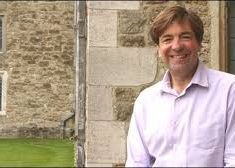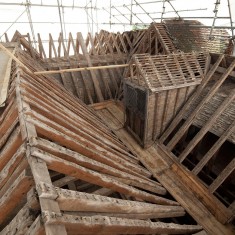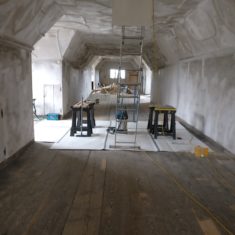In the middle of a six-year period of living with the then largest conservation project ever undertaken at one property by the National Trust, Robert describes first why he wrote his book ‘Inheritance’. He then describes how he witnessed the Inspired by Knole project evolving into one with real vision. He then reflects on how the stars were aligned and the timing of the project was perfect for Knole.
Robert Sackville-West
Lord Sackville, speaking about the Inspired by Knole Project (2013-2019)
Interviewed by Emma Slocombe and Veronica Walker-Smith in 2017
New work elucidates the past; the writing of 'Inheritance'
“It was an insight in a way, into how interesting big conservation and construction projects are in old houses; and how they are about more than just building and decorating and creating a new kitchen. How actually everyone, begins to learn something more, and new, about the history of a place. So there is a dimension to all this new work, which actually elucidates the past, as well. And that’s great.”
Interviewer: And do you think that was the catalyst for your first book ‘Inheritance’? Or had you thought about it for a long time?
“I’d thought about that; because I’d written in – I don’t know when – late ‘90’s – a National Trust guide book for Knole, so I’d got interested in the subject. I knew – this is slightly defensive argument – that if I didn’t write that book on Knole, somebody else would, at some point, and I wanted to be first! I wanted to learn more about the house in which I was going to live; and one of the reasons I wanted to do that was because at that time, there was obviously so much interest in Knole; and so many competing visions as it were, for what Knole was. And some of them were absolutely terrific. And actually the version, that was a great version, is the version that actually came through in the conservation project. But there were moments along their way when certain visions for Knole were not completely to my taste. So I thought I’d better get my own version of the myth down on paper! So that was one of the reasons.”
Interviewer: And are you able to encapsulate what that vision [version] is for you? Because the book is both a large history of a family; but also it’s a very personal reflection and what it feels like to be the current incumbent of Knole.
“What is the version? I think that the story is, I guess, a very obvious one; and it’s encapsulated in Vita’s title ‘Knole and the Sackvilles’. It is about a place and the people who have lived there. The same themes and personal preoccupations that are fairly consistent over centuries; that as both the place and people who live there try to resolve the relationship between themselves – the people – and also with the place. Because a place as big as Knole can be extremely domineering! And there have been times in the history of Knole when Knole has got completely on top of the people; and other times in the history of Knole when the people have actually managed to create something for themselves there. So I guess that’s what it’s about. It’s about the effect of place on people and vice versa.”
The Inspired by Knole Project became truly visionary
I didn’t feel necessarily at the very beginning that there was a vision; and if there was a vision it might have been more of an operational vision; because actually what the people talked about the whole time were – car parks; tearooms and toilets! And these things are fine and necessary, but they are not visionary aspects of the project. So that was a bit – well not nerve-racking, but you think: Oh God! Then, I think when the National Trust, and particularly you, Emma, started talking about – or asking the question “What is Knole all about? What is the spirit of Knole? What is particularly special about Knole?” Just answering that basic question, and the answers then began to evolve; did the project become interesting.
And it seemed to me – correct me if I’m wrong – that yes, there was a sort of aesthetic to Knole; which was a sort of faded grandeur; which is part of the characteristic of Knole which has not actually been lost in this project; but also there was a focus on, in the end, what at Knole is unique – which is the Royal Stuart furniture. That is the thing, where Knole has something which absolutely does not really exist anywhere else in the world. So when that realisation, and the need to preserve that, and therefore the need for conservation, and a conservation studio possibly and textiles; and the need to return those objects to a stable environment; and at that moment I thought that the project really came together, and began to make sense. And then questions about “Well, how do you make this process exciting to visitors? And can you watch the conservators in action? And how will the conservation studio look? And how do we re-present these objects in a way that is both more informative, but doesn’t, in any way, diminish that faded grandeur, that Knole has – doesn’t make it too new, or sparkling?” It was when discussions like that began to happen, that I thought “Well, this is a really good project.”
The stars were aligned for Knole
“I do think that it’s been a very good creative and constructive process basically, this project. And it’s one of the examples, I think, of collaboration. Actually this could not have worked if there had not been quite intense collaboration between the family’s interests and The National Trust; it just couldn’t; nothing would have happened.”
Interviewer: No. It would have carried on.
“It would have carried on. And Knole would be a poorer, slightly more dismal place if that had happened. No, definitely. It was critical. And the timing was perfect, it seemed to me, in retrospect; everything aligned, at more or less the right moment. Us moving here at that moment; the National Trust really wanting to do something about Knole, but initially not quite sure what; then the gradual articulation of a really good vision – and the appetite of The National Trust to undertake such a project; which I’m not quite sure, even if some of those stars had been aligned today, whether there would have been the same willingness to sink so many resources into this project. So I think all those things came together; and we’re all very lucky that they did.”









No Comments
Add a comment about this page